
Why do they call it a Margherita pizza? How was invented? What’s the origin of the most famous pizza of all? If you ever asked yourself any of these questions, you’re in the right place. And, if you think you know the answer to these questions, hold on to your seat: because all you know about what’s behind the name of Margherita pizza is wrong.
You’ve probably been told that Margherita pizza was named after the Savoy Queen. Or you’re among the wise people who know this is only a legend. But you’ll be surprised to know more: that we didn’t have any pizza known with that name until not so very long ago.
Curious? Well, let’s start from the beginning.
The legend of Margherita pizza
How was Margherita pizza invented, in reality?
It wasn’t called Margherita until the 60s
The legend of Margherita pizza
The “history” sets the birth date of Margherita pizza to 11 June 1889. We are just at the beginning of the newly born Italian kingdom: the unification of Italy happened in 1861, now the country was under one monarchy, ruled by the Savoy family. King Umberto I and Queen Margherita were visiting Naples, once proud capital of the Kingdom of Two Sicilies. They’ve been there before, but they needed to show themselves more to be accepted as new rulers by the people.
Queen Margherita decided it was time to taste the local food so much loved by the Neapolitans: pizza. But surely they couldn’t go to a pizzeria as normal people would do. So they decided to have someone come to the palace cooking for them. Pretty easy: they were staying at the Royal Palace of Capodimonte, and the place was already equipped with a wood-fired oven. It had been installed almost a century earlier by the former king of Naples, Ferdinand IV, who was so in love with pizza he wanted to have a chance to eat it whenever he wanted.
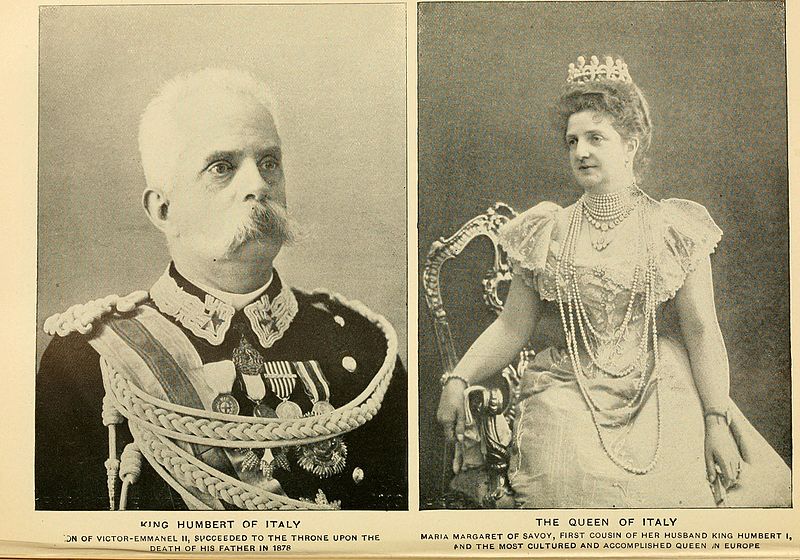
The “pizzajuolo” (pizza maker) invited to the palace by the Savoy monarchs was Raffaele Esposito. He was already pretty famous in Naples, thanks to the fact he had bought a popular pizzeria known as “Pietro… e basta così” located in Salita Sant’Anna di Palazzo (a street in the Chiaja neighborhood). But Esposito was even smarter: he previously changed the name of his pizzeria calling it “Regina d’Italia” (The Queen of Italy), like he knew that moment would come.
Esposito went to the palace with his wife, Maria Giovanna Brandi. He cooked his pizzas in the old Capodimonte oven (by the way: still perfectly working nowadays). He prepared three pizzas. The first one with oil, cheese, and basil: it’s the pizza we know as Mastunicola. A second one with “cecenielli” (the names used in Naples for bianchetti, the whitebait of some Mediterranean fishes). And the third one with tomato sauce and mozzarella, to which the wife Maria Giovanna decided to add a fresh basil leave.

The Queen tried the three of them. And she was particularly pleased by the last one, also teased by the fact that the red of tomato sauce, the white of mozzarella, and the green of basil reminded her of the Italian flag. So, after tasting it and finding it very good she asked Esposito “what’s the name of this pizza?”. And Esposito, with a stroke of genius, called it “Margherita”.
This homage made the Queen particularly happy. The day after Esposito received a thank you letter from Camillo Galli, the great chamberlain at the palace. The fame of the pizzaiolo grew even more and now everyone wanted to taste this pizza so loved by Queen Margherita. And that’s how Margherita pizza was invented and became so famous.
Or so the legend goes…
How was Margherita pizza invented, in reality?
The famous recipe presented to the Queen was nothing unseen in Naples. We have written proof that a pizza with tomato sauce, mozzarella, and basil was already a staple in the pizzerias of the city. It’s in fact described in the 1853 book by Francesco De Bourcard “Usi e Costumi di Napoli e contorni descritti e dipinti” (Customs and Habits from Naples described and depicted). There is a whole chapter, called “Il pizzajolo”, that makes a detailed depiction of the work of the pizza maker, and the ingredients used. Among them, tomato sauces and slices of mozzarella were already listed as a pair. But this prototype of the famous Margherita was just a pizza like any other, not so popular.
But do we know when Margherita pizza was invented? Let’s look at the set of norms and rules approved by the European Union for listing the Neapolitan pizza among the Traditional Speciality Guaranteed. This set was written by AVPN (the association for the true Neapolitan pizza) and it clearly states that “the Margherita pizza was invented between 1796-1810 and was then offered in 1889 to the Queen of Italy”.

So I asked myself: why that range of dates? And I laid the question to the president of the association, Mr. Antonio Pace. He told me they found a watercolor painting from that period representing a scene from Naples, and the Margherita pizza was in it. He told me it was sold at an auction at Sotheby’s, but couldn’t give me any more details, nor I found any online. But again, there’s no evidence of the fame of that pizza and its name.
So we should thank Raffaele Esposito for offering it to Queen Margherita and popularized it with that clever marketing strategy of calling that pizza after her, right?
Wrong. Because it seems that this “historical” episode has never really occurred.
Thanks to Scott Wiener’s blog, I found a long, very well documented article written by American food historian Zachary Novak that debunks the whole story of the pizzaiolo summoned at the palace. And he looks at that very same letter as the main proof. Yes, because the thank you letter allegedly sent from the Royal Palace is still proudly hanging on the wall, framed of course, in the pizzeria at that time owned by Esposito. That pizzeria is known today simply as Brandi: it was bought at the beginning of the XX century by Maria Giovanna’s nephews.
Novak checked the archives of the Royal Palace and found no evidence of a letter sent by Camillo Galli that day, let alone to a pizzaiolo named Raffaele Esposito on any other day. Also, looking at that letter, he noted something: it was handwritten, header included, and the royal seal applied by a rubber stamp.
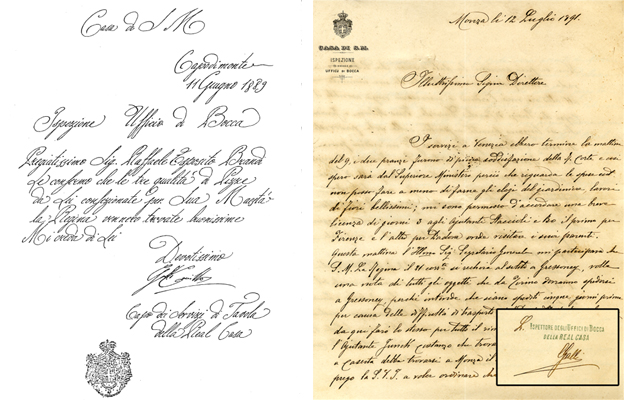
However, the Royal family had their letterheaded stationery, with a printed seal. Novak compared it to another letter sent by Camillo Galli from the Royal Palace of Milan, and he noted two things. First, the printed seal and the rubber stamp seal were quite different. Secondly, the handwriting was not the same.
Could it be that the famous letter was forged? The journalist had a theory: it could have been a marketing move worked out by the pizzeria’s owners, who were suffering the crisis and the competition of other more popular restaurants (like Pizzeria Port’Alba, pretty famous in the ’30s). They made up the whole episode – and the letter – to tie their brand to the success story of their aunt’s husband and the invention of Margherita pizza.
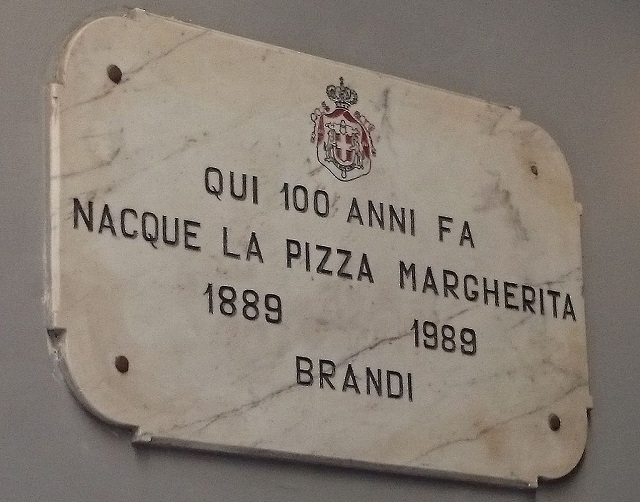
Fascinating theory, but let me point out that there’s a little flaw: if you read the letter there’s no mention of a Margherita pizza. It only says “I confirm you that Her Majesty found your three pizzas to be really good”, without specifying the type of the ingredients. Why forging a letter meant to be the undeniable proof of the invention of Margherita pizza, if you don’t name it on that letter?
Still, in 1989 a plaque was unveiled outside the pizzeria: “Here 100 years ago the Margherita pizza was born”, recites. That statement is twice false, as we know it existed before, and even if it was invented by Esposito, that happened at the Royal Palace of Capodimonte, not at the pizzeria.
Alright, but do we know how the Margherita pizza got that name, then?
It wasn’t called Margherita until the 60s
You read it right. But let me clarify. A pizza with tomato sauce, mozzarella, and basil leaves was already a thing by at least the end of the XVIII century. But it had no name until more recent times. Actually, no pizza had it.
I spoke to another food historian, Tommaso Esposito, and he told me something interesting: until after the Second World War, pizzerias had no menus at all. When you wanted a pizza all you had to do was to go to the counter, say to the pizza maker which toppings you wanted, and then waiting for your order at the table.
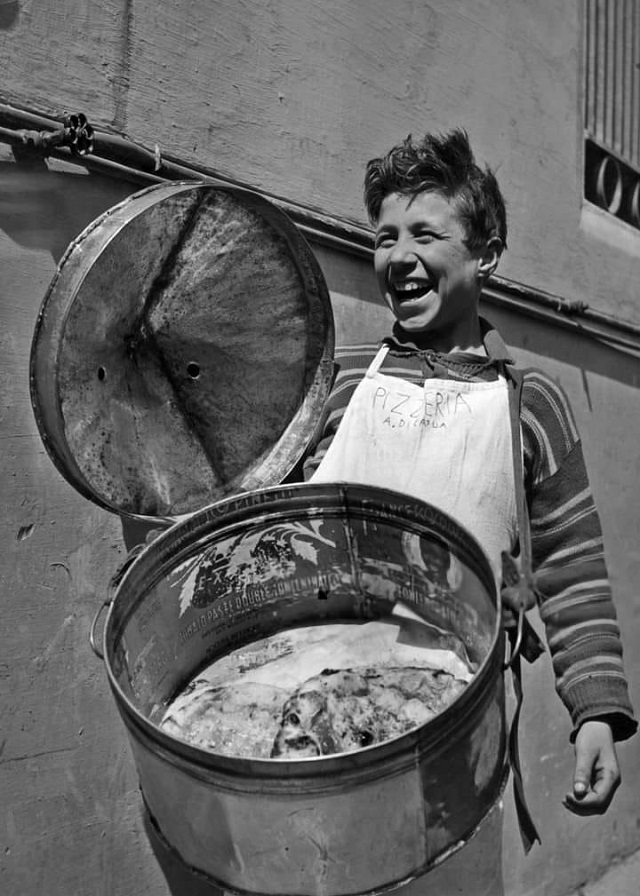
Esposito wrote an interesting book called “‘A Pizza, viaggio nella canzone napoletana” (Pizza, a journey through the Neapolitan songs), where he collected lyrics of songs about pizza from the XVI century until the year 1966 (year of the famous song “‘A pizza”, by Giorgio Gaber and Aurelio Fierro). Not even one song had a pizza name, and only a few of them mentioned some ingredients.
Looking back at other historical books, pizza was always mentioned as a traditional specialty from Naples: but they were always described listing the most common ingredients used, not any particular combination with a name. One notable example is the “Gastronomic guide of Italy” issued by the Italian Touring Club in 1931. That was still during the Savoy period: if any pizza called Margherita really existed in Naples, Esposito says, why writers working for a national cultural institute wouldn’t have taken the chance to pay an homage to the royal family quoting the famous episode of the Queen? And yet, it is quite a popular legend to report on the travel guides today.
Antonio Pace himself told me that the very first pizza championship was organized in Naples in 1964, at the Mostra D’Oltremare expo space. And he remembers pizzaioli going around shouting and offering to the people a pizza with tomato and mozzarella, calling it “Margherita”.
The first recorded proof of a pizza with this name is in a documentary made by the national tv channel RAI in 1967 (and available on YouTube). You can see a Neapolitan reporter asking a pizzaiolo if the Margherita pizza was the one with “an egg in the middle”. To which the pizzaiolo responds “No, the Margherita I was taught is simply with tomato sauce, mozzarella, cheese, and basil”. That shows that it was probably called Margherita even before the 60s, but there was still confusion about what pizza was associated with that name. It is hard to believe that a journalist from Naples wouldn’t know what a Margherita pizza was if it was such a long-established classic.
There’s more: the pizzaiolo actually says “There is indeed a pizza with the egg, but is not called Margherita anymore“. Thus, implying the Margherita we know today is a different one than they knew in the past. There’s in fact another theory that says the name Margherita comes from the daisy flower: the cooked yolk place in the middle reminds the pollen, the fiordilatte was laid in slices around like they were white petals, and the fresh basil was actually the leaves of the flower. The menu below is apparently from 1944, from pizzeria Da Attilio in Pignasecca street: the Margherita pizza is not at the top of the menu like it is today. Probably it was not that popular at the time, and it was even different.
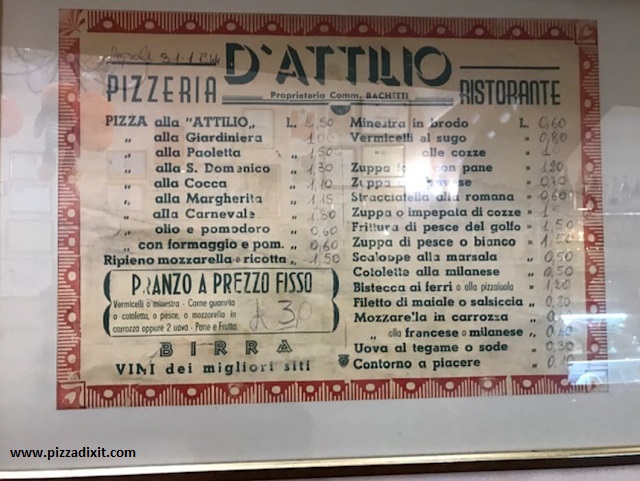
We even have an older video of a pizza, and it’s in a scene from a movie, “San Giovanni Decollato” (St John’s the Beheaded), starring one of the most popular Italian actors ever lived, Totò. Antonio De Curtis, his real name, was from Naples, and his movies were always set in his hometown (although shot mainly in Rome). In this movie from 1940, he is served a pizza at a table: when serving it, the pizza maker simply says “your pizza”, not calling it with the name like they would do today. Of course, being a movie, this proves nothing, but maybe it says something about the custom of that time.

The end of the story? Until new evidence will be found, we can’t really say who invented the Margherita pizza. We don’t know why, when, and how it was named like that, and the real origins. But we know for sure one thing: that is the best invention ever made by the Neapolitan people.
(An Italian version of this article was originally published on Storie di Napoli)
